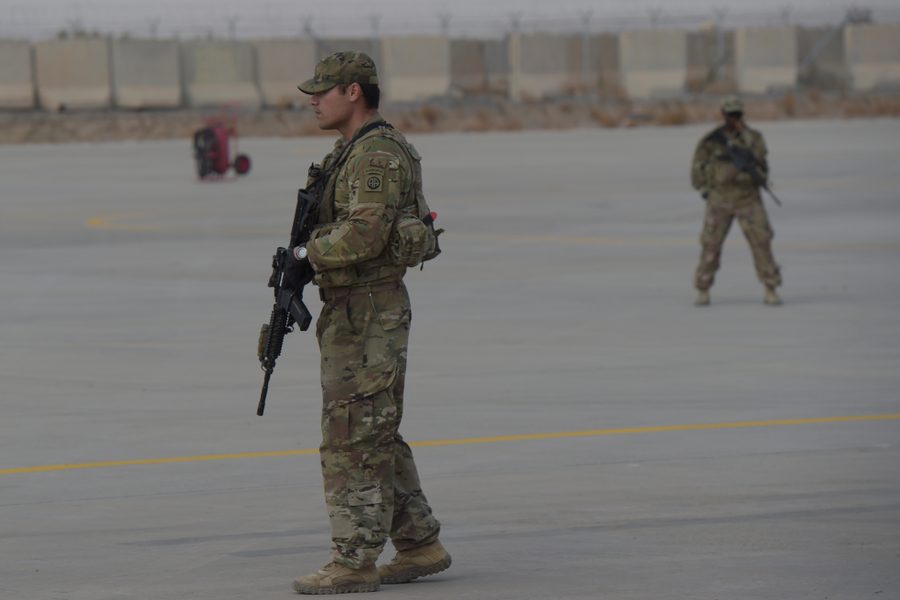U.S. Out of Everywhere
The case for an immediate withdrawal from Syria, Afghanistan and Iraq.
Azadeh Shahshahani

Trump’s December 19 announcement of troop withdrawals from Syria and Afghanistan led to immediate opposition not only from the Right but also from liberal commentators, demonstrating the overlap between liberals and the right wing when it comes to the imperialist U.S. foreign policy. This overlap was illustrated again on January 31, when a bipartisan majority of the Senate voted to move forward with a bill rebuking what they describe as Trump’s “precipitous” withdrawal of troops from Syria and Afghanistan.
Many commentators argue that the U.S. political system has become increasingly polarized, pointing to the prolonged shutdown of the federal government as evidence. However, the difference between Democrats and Republicans in Washington is one of style, not substance, as revealed by the history of bipartisan support for U.S. intervention and occupation abroad. Republican administrations may be more frequently associated with U.S. invasions, but establishment Democrats have long backed the policies of U.S. imperialism.
This is, in part, because U.S. interventionist foreign policy is driven by capitalist ideals, shared across the aisle by those in power in Washington. In order to sustain a profitable capitalist economy, there must be a continuous expansion of markets and increase in consumption. This capitalist imperative has been influential in shaping a U.S. foreign policy of invasion, destruction and resource extraction during open-ended wars. In 1971, the Uruguayan writer Eduardo Galeano famously described this extractive relationship as “the open veins of Latin America.” The rhetoric of defending democracy, which was used to justify the invasion of Syria as well as the occupation of Iraq and Afghanistan, has always been a cover story for neo-colonialism.
U.S. intervention, operating under this cover story of spreading democracy, has historically led to the long-term destruction of countries and exploitation of their natural resources. One only need look at Libya, Syria, Iraq and Afghanistan in recent history, not to mention continuing U.S. support for the brutal Saudi-led war on Yemen.
U.S. intervention in Syria
The U.S. military has had troops on the ground in Syria for four years. In 2015, President Obama deployed 50 Special Operations troops to Syria, and there are currently 2,000 troops currently stationed there. As happens with many of the wars the U.S. wages abroad, the justifications for invasion and long-term military occupation in Syria have shifted over the years. U.S. intervention was originally nominally aimed at ousting Bashar al-Assad. But by 2014, with Assad still firmly in power, the U.S. claimed to be fighting the Islamic State with an aggressive campaign of airstrikes. Since then, the U.S. narrative has been one of “liberating” people from the Islamic State, but the untold death and destruction that comes in the wake of the military operations will likely take generations to overcome. The country has been decimated by this foreign-backed war. According to an estimate from the United Nations, the war has cost the country nearly $400 billion, with the destruction in physical capital alone amounting to $388 billion.
The destruction of Syria is also a project of capitalist expansion and value drain. Like many other countries in the region, from the 1990s onwards, Syria succumbed to a mixture of internal pressure from the ruling class and external pressure from western states and international financial institutions to liberalize its economy. When Assad took office in 2000, he lifted state controls on private investment, reduced tariffs and opened the economy to foreign investment and trade. These types of reforms are hallmarks of the free-market capitalist ideology that the U.S. has tried to impose across the world.
By 2011, these economic reforms, combined with the euphoria of the Arab revolutions, led to an uprising. Early demands of the populist uprising included both economic and political reforms. However, the public’s resistance was quickly met with violence and repression. The UN estimates that 5,000 Syrians civilians were killed in 2011 alone.
Yet it was largely external factors that transformed Syria into the nightmare it has been unable to exit from. The civil war that broke out inside Syria in 2011 was quickly subsumed into the ongoing geopolitical power struggle. The U.S. alongside Turkey, Saudi Arabia, Qatar and Israel, financially supported and armed opposition fighters battling the Syrian government. In their article, “Investment and Neoliberalism in Syria,” Linda Matar and Ali Kadri explain that although Syria is not rich in resources, “it is strategically located and its control imparts strategic gains to whichever imperialist power holds it in the end.”
The rapid and coordinated assault on Syria reflects U.S. determination to maintain its power in the Middle East. The War Powers Act requires the president to give reports to Congress on the U.S. use of military force abroad. In the 2018 War Powers Transparency report, the Trump administration claimed that the ongoing campaign of airstrikes in Syria has “liberated 4.5 million people from ISIS oppression in 2017,” and that the current mission is one of “liberating the middle Euphrates River valley in Syria.” But U.S. intervention in Syria has decimated the country through relentless bombing, ostensibly targeting ISIS.
While the politicians in Washington call Trump’s proposed withdrawal of troops irresponsible, and argue for endless occupation in the name of “stabilization,” airstrikes by the U.S.-led coalition continue. Since Trump’s announcement in late December, Airwars has reported 40 separate coalition airstrikes which have claimed the lives of hundreds of civilians in Syria. Although the law requires compensation for civilian survivors and victims of attacks that were in violation of international law, the U.S.-led coalition has shown no intention of taking responsibility for or compensating survivors of these attacks.
Meanwhile, the destruction from the overall conflict, including airstrikes from the Syrian and Russian governments, is staggering. Sources today estimate that more than 500,000 Syrians have been killed since the beginning of the war and almost two million have been injured. Additionally, more than half of the country’s population, between 11 and 12 million people, have been displaced and forced to flee their homes due to the unrelenting violence. More than 5 million of those displaced have moved abroad where many have registered as refugees. For the civilian population in Syria, this has been an era of death, destruction, and displacement — not liberation.
In December, California Democrat Ro Khanna, a staunch critic of American interventionism, authored an Op-Ed for the Washington Post titled, “Trump was right to pull out of Syria and Afghanistan. This is what he should do next.” He notes, “the presence of U.S. troops in the Syrian civil war was never authorized by Congress,” and the U.S. is “violating international law by invading Syria without approval of the United Nations.”
Critics of Trump’s decision to pull troops from Syria have argued that the U.S. is abandoning the Kurds who control areas of Northern Syria and have created a zone of self-governance and autonomy there. Kurdish fighters have been instrumental in reclaiming the territory that ISIS once held. Recently, a representative of the Kurdish people declared that the mission to defeat ISIS in Syria has been completed, calling it a 100% victory. Although pulling U.S. troops may leave the Kurds vulnerable to Turkish invasion or aggression from Assad’s regime, an indefinite U.S. military presence has never proven to be a stabilizing force — or a boon to revolutionary people’s movements abroad.
U.S. Intervention in Iraq
U.S. military intervention in Iraq has a long, violent history. In 1963, the U.S. and Britain backed a coup against Abd al-Karim Qasim, a popular leader who overthrew the British installed monarchy in Iraq. Qasim swiftly declared Iraq a republic and began implementing widespread reforms, including a plan to nationalize the British-controlled oil reserves. The U.S. and Britain reacted to his rise to power and his leftist reforms with panic. Eventually the powerful countries backed the coup against Qasim in order to pursue their economic and imperialist ambitions. The party that came to power was the Baathist party, including their high-ranking member, and future president Saddam Hussein.
In 1990, the U.S. government launched the Persian Gulf War against Saddam Hussein, a leader the U.S. helped bring to power and supported for decades. During this war, U.S. bombing was targeted at crucial infrastructure and resulted in the destruction of decades-long development in Iraq. Although the Persian Gulf War ended in 1991, the U.S. military assault on Iraq continued on. Throughout Bill Clinton’s presidency, the U.S. military quietly carried out systematic bombing of Iraq in what would become the longest sustained U.S. bombing campaign since Vietnam. Beginning in the immediate aftermath of the Persian Gulf War and lasting until the U.S ground invasion in 2003, the U.S. military conducted airstrikes against Iraq justified as protecting “No Fly Zones” that had been established at the end of the Persian Gulf War. These No-Fly Zones were ostensibly to protect Iraqi ethnic minorities from the possibility of Saddam Hussein using aircrafts.
This U.S. bombing campaign was accompanied by the imposition of devastating economic sanctions that prevented humanitarian aid from reaching Iraq. By 1995, UN reports estimated that over the previous four years, as many as 576,000 Iraqi children died as a result of these sanctions. In a 1996 interview with 60 Minutes, then UN Ambassador Madeleine Albright was asked whether, given the deaths of over half of a million Iraqi children, the price of continuing to impose these economic sanctions was “worth it.” She responded, “We think the price is worth it.” Denis Halliday, the UN Humanitarian Coordinator in Iraq, resigned in 1998 from his position over the sanctions against Iraq. He later described them as constituting genocide.
In March 2003, the U.S. invaded Iraq with the stated mission to destroy Iraqi weapons of mass destruction and end the rule of Saddam Hussein. According to The Shock Doctrine, by Naomi Klein, from March 20 to May 1, the U.S. military dropped roughly 30,000 bombs on Iraq, and 20,000 precision-guided cruise missiles. After this month of relentless bombing, the U.S. declared victory in “The War in Iraq.” Television stations broadcast the monument of Saddam Hussein being toppled in the streets and then President George W. Bush posing in front of a banner reading “mission accomplished.”
In the immediate wake of this declared victory, the U.S. appointed Paul Bremer to take control over the government in Iraq, even though he did not speak Arabic, had no experience with postwar reconstruction, and had never visited Iraq. Bremer is credited with decisions such as abolishing the Iraqi army overnight and reopening Abu Ghraib, where the U.S. infamously detained and tortured thousands of Iraqis.
The U.S. invasion and occupation of Iraq played a key role in creating ISIS. President Obama admitted as much in an interview where he described ISIS as an example of “unintended consequences.” Then, defeating ISIS became the justification for an indefinite occupation in Iraq and assault against the country.
In 2014, an international coalition led by the U.S. began airstrikes and military action against ISIS in Iraq. This assault was dubbed Operation Inherent Resolve. Four years later, in 2018, Airwars reported the Coalition actions had directly caused between 6,500 and 10,000 civilian deaths.
In 2018, the U.S. announced the end of “major combat operations” and the closing of the coalition command center. Although ISIS no longer holds any significant territory in Iraq, the U.S. military remains an occupying force in the country. In August 2018, a spokesman promised that the U.S. will stay in Iraq “for as long as needed.”
A research project by Brown University called “The Costs of War” has estimated that in Iraq, from March 2003 to October 2018, the total number of deaths directly attributable to post-9/11 War in Iraq was between 268,000 and 295,000. The researchers warn that this number is likely an underestimate due to lack of reporting and lack of transparency by the U.S. government. Furthermore, this number does not account for the untold number of “indirect deaths” that have been caused as a result of loss of access to food, water and other basic necessities. Others have put the estimate of Iraqis killed at 1 million.
The Costs of War report estimates that the number of refugees and internally displaced people in Iraq is roughly 3,250,000.
Today, there are some 5,200 U.S. troops based in Iraq. In a press conference during his first visit to Iraq, Trump said that he has no plans to withdraw troops from the country. Instead, Trump suggested that the U.S. use Iraq as a staging ground in the Middle East: “we can do things from Iraq … we could use this as a base if we wanted to do something in Syria.” Recently, Trump also said that he wants the U.S. military to stay in Iraq to keep a close eye on Iran.
U.S. intervention in Afghanistan
Within a month of the Sept. 11, 2001, attacks, the U.S. was leading an invasion of Afghanistan with the claimed mission to kill Osama Bin Laden and defeat al-Qaeda’s leadership. This operation soon expanded to include fighting the Taliban in Afghanistan. The 2001 invasion marked the beginning of a deadly and unending 17-year assault and occupation of the country.
In 2003, Donald Rumsfeld declared an end to major combat in Afghanistan claiming the U.S. would be moving “to a period of stability and stabilization and reconstruction activities.”
But today, it’s clear that U.S. government’s stated mission to defeat the Taliban has failed. Last year, the New York Times reported that the Taliban held more territory than ever before as they battle the Afghan government for control.
The war continues to drag on, mostly out of sight and out of mind for the U.S. public. In 2017, Trump announced a new plan for U.S. engagement in Afghanistan saying, “We are not nation building again. We are killing terrorists.” The latest War Powers Transparency report notes that in Afghanistan, “the United States remains in an armed conflict, including in Afghanistan and against al-Qa’ida, ISIS, the Taliban, and the Taliban Haqqani Network.” Yet, the U.S. has also positioned itself as the broker of peace talks between the Taliban and the Afghan government. Considering the U.S. role in creating and escalating this conflict, it is absurd for the U.S. to justify its on-going intervention in the name of negotiating peace.
The conflict in Afghanistan has resulted in roughly 4.78 million refugees and internally displaced people and a conservative estimate of 147,000 deaths in war zones. In 2018, the U.S. dropped the greatest number of bombs since the 17-year-old war began. According to the UN Assistance Mission in Afghanistan, just in 2018, there were 2,798 civilian deaths and 5,252 injuries. Human Rights Watch has reported that the U.S. and Afghan governments are not adequately investigating possible unlawful airstrikes in Afghanistan.
In December, Trump announced that, in addition to Syria, he is ordering the military to start the process of withdrawing 7,000 troops from Afghanistan. This announcement of a limited withdrawal, which constitutes only half of the 14,000 U.S. troops currently in Afghanistan, provoked panic in Washington, in another illustration of the meeting of the minds between the Democrats and the Republicans when it comes to U.S. foreign policy.
The U.S. has no business to intervene in Syria, Iraq, Afghanistan or any other country — whether in the name of “counter-terrorism,” “democracy promotion,” or “state-building.” It is time to revive the anti-war movement in the U.S. in order to push the political establishment (both liberal and rightwing) to abandon its imperialist policies and white-savior tendencies. The U.S. should also acknowledge the calamitous impact of U.S. intervention in other countries and pay reparations to the peoples and countries that it has invaded, destroyed and exploited over the past centuries.
The author would like to thank Luce Randall for the research help with this article and Dr. Corinna Mullin for her review and feedback on drafts of the article.
Azadeh Shahshahani is legal and advocacy director at Project South and a past president of the National Lawyers Guild. She tweets @ashshahahani and you can read her work at In These Times here.







